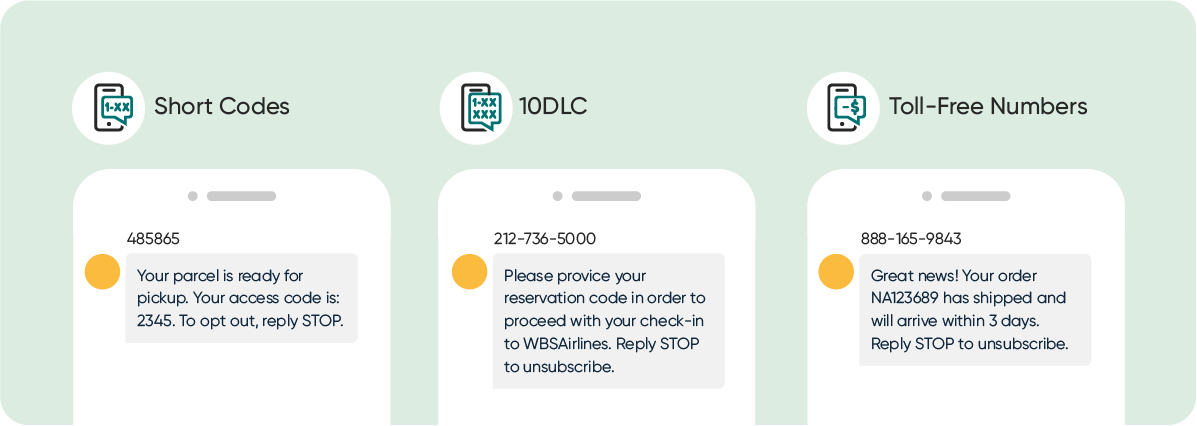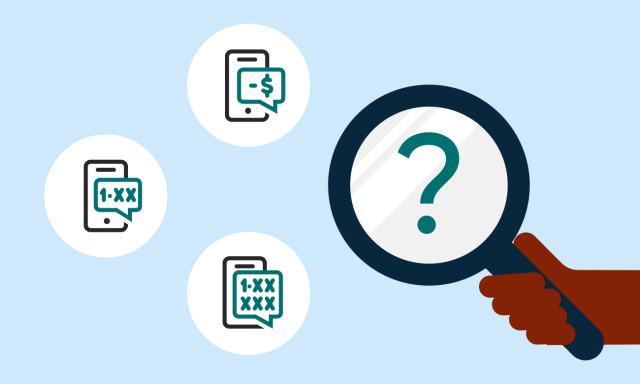In this article:
- What is an SMS short code?
- What is a 10-digit long code, or 10DLC?
- What’s an SMS-enabled toll-free number?
- What is a long number?
- Which type of SMS number is right for your business?
- Who do you want your messaging to reach?
- What features do you need?
- How many messages will you be sending?
- How quickly do you want to start sending?
- How do long numbers, short codes, 10DLC, and toll-free numbers compare?
So you want to text your customer base in the U.S. and Canada - but you’re not sure how to do it? It’s a jungle out there with SMS Short Codes, 10DLC, and Toll-Free Numbers!
We’re here to walk you through the different phone number options that let your business send and receive SMS messages online. Here is what you need to know.
What is an SMS short code?
Short codes are 5-6 (or 8) digit numbers used for A2P messaging in the U.S. and Canada. They’re easy to remember, and when used effectively, can become a recognizable part of your brand. Short codes are a well-established business messaging channel and are best suited for high volume messaging or use cases where immediate message delivery is critical. They support multimedia messaging (MMS) and delivery receipts but not voice.
What is a 10-digit long code, or 10DLC?
10-Digit Long Codes (10DLC) are a new messaging solution in the U.S. using a local phone number that’s already associated with your business. They support voice services and MMS, but not delivery receipts, unlike short codes.
Take a look at this 10DLC webinar, 10DLC: the new standard in business messaging, to learn more about 10DLC, how it compares with Toll-Free Numbers and dedicated Short Codes, most common use cases, and more. Already familiar with 10DLC? Listen to our deep-dive session to understand the ins and outs and learn how to implement it successfully.
What’s an SMS-enabled toll-free number?
Toll-free numbers are numbers with distinct three-digit area codes that can be dialed from landlines with no charge to the caller. These numbers are available in the U.S. and Canada and have been sanctioned as a business messaging channel for several years. You can use toll-free numbers for all types of A2P messaging, including marketing. (Remember, though, that it’s important that users have opted-in to receive marketing content!) They support voice, MMS, and delivery receipts.
What is a long number?
Long numbers are for P2P messaging only. You can’t use them for marketing or A2P messaging in the U.S. And they’re going out of style! In fact, U.S. carriers have mandated that all businesses using long numbers switch to a sanctioned business messaging channel (short code, 10DLC, or toll-free) or face fees, fines, and heavy filtering or blocking.

Which type of SMS number is right for your business?
One size doesn’t fit all - let’s consider your specific requirements!
Who do you want your messaging to reach?
Short and snappy, short codes are easy to remember and generate high levels of engagement with customers nationwide. If you’re hoping to gain brand recognition and are expecting high volumes of customer interactions as a result of your SMS and MMS messages, then short codes are the way to go!
Toll-free numbers can help maximize your reach, since you can use one number for both the U.S. and Canada. Besides, most customers already use toll-free numbers to call companies today, so use these trusted numbers to engage in 2-way conversations with them via SMS, or MMS too!
But if a local presence is important to you, consider 10DLC. With these area-code specific numbers, you can start 2-way conversations and send powerful messages, including images or video with MMS, to get campaigns noticed. With 10DLC, you also avoid getting caught up in spam filters with carrier campaign registration. All important things when it comes to trusted messaging!
What features do you need?
If you need one number for your business that supports calls and text, then both 10DLC and toll-free numbers are great choices. Does your message program require “free to end user” (FTEU) messages? Short codes are the only channel that support this special use case. If you need to be absolutely sure that a message reaches the end user, choose short code or toll-free – both support handset delivery receipts.
How many messages will you be sending?
When it comes to sending hundreds of messages per second (mps), short code is the best option. You can reach 500 mps or more on a short code.
The standard throughput on a toll-free number depends on account and supplier configuration, but these numbers can allow for fast message delivery (at speeds comparable to short codes) depending on the use case. 10DLC speeds also vary with the type of business and messaging use case and can reach speeds up to 75 mps – or more (special carrier approval is required).
How quickly do you want to start sending?
In a hurry? 10DLC and toll-free numbers take only a few days to set up. If you have a straightforward use case, you can register and activate a 10DLC in a matter of days, if not the same day. Keep in mind, though, that if you have specific throughput needs, a 10DLC may take 3 to 4 weeks for approval. Likewise, toll-free numbers take only a few days to register and activate. So, if it’s speed-to-market you’re after, then look at 10DLC or toll-free numbers.
Short codes go through a rigorous approval process, which means they’re some of the most trusted numbers around. Because of their lengthier review process with U.S. carriers, it can take 3 to 6 weeks before you can begin sending messages from a short code. Once approved, short codes are a reliable and fast messaging channel for your business.
How do long numbers, short codes, 10DLC, and toll-free numbers compare?
| Traditional Long Number | Toll-Free Number | Short Code | 10DLC | |
| Digit length | 10 digits | 10 digits | 5-6 digits | 10 digits |
| Messaging model | P2P | A2P | A2P | A2P and P2P |
| Voice enabled | Yes, U.S. and Canada | Yes, U.S. and Canada | N/A | Yes, U.S. and Canada |
| Requires brand vetting | No | No | Yes, U.S. only | Yes |
| Requires campaign approval | No | Yes | Yes | Yes, via TCR (The Campaign Registry) |
| Provisioning | 1-3 business days | 1-5 business days | 3-6 weeks |
Standard: 7-10 business days SBC: 3-4 weeks |
| Throughput | 1 msg/sec | 10 msg/sec*** | 10-500 msg/sec | Up to 75 msg/sec with MNO approval |
| Delivery Receipts (DLRs) | No | Yes, U.S. and Canada* | Yes | No handset DLR, SMSC DLR in most of NANP** |
| MMS | Yes, U.S. and Canada | Yes, U.S. and Canada | Yes, U.S. only | Yes, U.S. and Canada |
| Keywords required | No | Stop, Unstop - Network managed | Opt-in/out and Help | Opt-in/out |
| FTEU | Not supported | Not supported | Available | Not supported |
| Endorsed by U.S. carriers | No, carrier filtering/blocking | Yes | Yes | Yes |
| Endorsed by CTIA | No | Yes | Yes | Yes |
| Supported U.S. carriers | All | All | All | AT&T, Verizon, T-Mobile/Sprint, US Cellular |
* Canada - Bell support TBD as of January 10, 2021
** NANP: North American Numbering Plan countries: U.S., Canada, U.S. territories, and the Caribbean
*** Standard throughput is 10 msg/sec. Higher throughput is available, depending on use case, at speeds comparable to short codes. Contact us to get more information.
Choosing a number for sending and receiving texts is a big step towards opening up a new and important communication channel with your customers, but there’s more you should know before you get started with SMS for your business.
If you’ve got customers in the U.S, grab our SMS Compliance Guide for a run-down of best practices and a useful checklist you’ll want to keep handy!
Need a bit more information to help you make a decision? Take a look at our Short Codes, 10DLC, and Toll-Free Numbers product pages for more details, or get in touch to discuss further. We can’t wait to hear from you!



